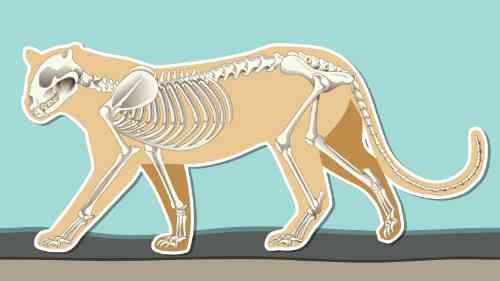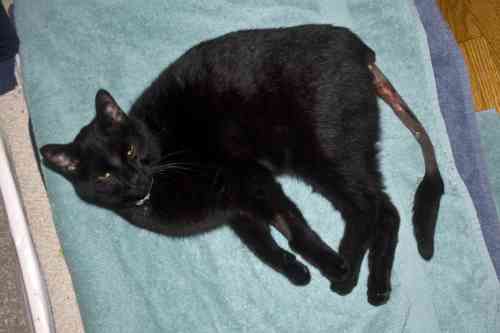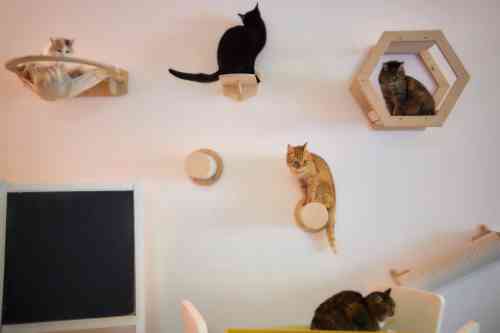A limp tail in your cat
How did it happen?
If your cat comes home with a limp tail, you are naturally concerned about it. Rightly so. After all, it can be quite serious. In this article you can read how a cat can get a limp tail, how to determine the cause and what to do. If there is only pain, you can take care of it at home and support him with the resources we show your. So read on to find out how you can help your cat with its limp tail.
Why is my cat’s tail limp?
If you have a cat with a limp tail, you obviously want to know why this happend. In principle two things are possible.
The first is that your cat has pain when moving his tail. In that case he lets him hang loose so that as little muscles pull at it as possible. That way he has as little pain as possible.
Secondly, the nerves may not be able to control the muscles. This may be due to a problem in the muscles, but in most cases there is a blockage in one of the nerves that control the tail.
Anatomy of a cat’s tail
Below is an image of a cat’s skeleton. As you can see, the tail contains all fairly straight bones that are neatly arranged after each other. They are attached to each other with cartilage. There are a lot of muscles and tendons around the bones of the tail. They ensure that the tail can bend and straighten. The muscles must be supplied with blood and nerves in order to work. So blood vessels and nerves are also in your cat’s tail and run between the muscles. There is skin around the bones, muscles, tendons, blood vessels and nerves that protects the internal tissues of the tail.

You might imagine that it takes a lot of muscle furce to get your cat’s tail up in the air. If those muscles or the movement itself hurts the tail, your cat will use those muscles as little as possible. But If the muscles do not work at all, your cat can’t even use the muscles of its tail. If your cat has a limp tail, the question is whether he does not WANT to move his tail or CAN’T.
What other symptoms can you see besides a limp tail in your cat?
There are more possible symptoms you may notice in your cat:
- Your cat’s tail hurts when you touch it
- Your cat licks its tail a lot
- His tail may be swollen
- There may be small wounds on his tail
- The tip of its tail may be worn bald as he drags his tail over the ground.
- Your cat may be less active than he used to
- Other symptoms may be visible on the rest of his body such as (small) wounds, split nail tips, broken teeth, etc.
- It may be more difficult for him to keep his balance because he does not use his tail
- There may be problems with defecating and/or urinating
It is therefore important that you carefully examine your entire cat to see if any other abnormalities are visible. In a collision with a car or bicycle, for example, you often see worn nail tips. A fight with another cat often results in more small scabs on the rest of your cat’s body.
What does your cat use its tail for?
Your cat normally uses his tail for multiple purposes.
- Keeping balance: a study performed by Curt Walker showed that cats are less able to keep their balance if their tail is not functioning.
- Communication with other cats: other cats can tell by the position and shape of the tail whether the cat tolerates them or not. S. Cafazzoa and E. Natoli have investigated this function.
- Showing their mood: you can tell by the position of their tail whether they are feeling comfortable or sick.
- Heat regulation: by wrapping the tail around their body while sleeping, they keep their body extra warm.
- Scent marking: at the base of the tail there are scent glands that allow them to emit a scent against objects, other animals and people. According to research done by Patrick Pageat and Emmanuel Gaultier, this shows that they are some how “connected” to those objects.
In the case of a cat with a limp tail, your cat may also have problems with other cats in the household because his body language suddenly can no longer be communicated properly and he can no longer release his scent to objects and thus touch them a bit. That way he can’t commit to those objects anymore.
What causes your cat to have a limp tail?
As we mentioned, your cat may have a limp tail because he chooses not to move his tail. Usually because it hurts him to move the tail. But it is also possible that he cannot move his tail because an important nerve is damaged that allows your cat to contract his tail-muscles and thus move his tail. We will explain it to you in more detail below.
A painful tail
If your cat has pain in its tail for some reason, it will prefer not to move it. After all, movement of a painful body part causes additional pain. To keep a tail up, even in an immobile position, he has to contract quite a few muscles to get his tail up into the air. After all, that tail has to overcome gravity. Normally this will hardly require any effort for your cat. But if his tail is painful for some reason, he will choose to have less pain. As a result, he lets his tail hang limply and lets gravity do its work.
Pain in your cat’s tail can be caused by an accident, a fight or an infection. That is why it is important that you examine your cat further. For example, if he also has split nail tips, there is a good chance that he has been hit by a car. If he has all kinds of small wounds on his body, there is a bigger chance he was in a fight. If he even has a fever, then there is most likely an infection and therefore an abscess in his tail.
A paralyzed tail
If there is a paralyzed tail, there is a problem with the nerves that control your cat’s tail. It is also possible that he has a muscle disorder in his tail, but that is rare in cats. In most cases, a paralyzed tail is caused by an accident with a vehicle in which the tail has been jerked in one way or another. The nerve is then stretched or even torn and can therefore no longer transmit a signal from your cat’s brain to the muscles in his tail. The result is that your cat has a limp tail. If your cat also has difficulty standing and walking, he may even have a bruised or broken pelvis.
Diagnosing the cause of a limp tail in your cat
Physical examination of your cat’s entire body
So it is important that you fully examine your entire cat. Provided he allows it, of course. Approach him calmly and pet him first. This way you can see whether he responds to your love in a normal way. Does he clearly indicate that he wants to be left alone? Then leave him alone for fifteen minutes and then try again.
As soon as he allows it, try to examine his head. His teeth and jaw in particular are often damaged after a collision. See if he has any (small or large) wounds on his body. Small wounds are often caused by the nails of an angry neighbour’s cat. Larger abrasions are often caused by collisions. Also try to check his nails to see if they are frayed at the tips. They often extend their nails during a collision. The impact of the car or bike then drags their nails across the ground and wears them off.
Examine your cat’s paws
Also feel and bend all of your cat’s legs to see if they still function normally and are not swollen. Also let your cat walk a few steps so you can see how he uses his legs. The hind legs are particularly important in this case. With a broken pelvis we often see damage to the nerves of the tail, but also an unsteady gait while walking. Also gently press on your cat’s pelvis to see if the pelvis feels painful and may be damaged.
Detailed examination of your cat’s tail
Finally, focus on your cat’s tail. You do this last because the tail may be so painful that your cat will no longer want to cooperate with further examination of its body after examining it. Gently lift your cat’s tail into the air and see if you can tell that moving it is painful for your cat. Feel if there is a point where there is more mobility than normal and if the bones are no longer lined up nicely. In that case the tail may be broken. Also examine whether you feel any swelling in his tail that is painful. Do you only feel a swollen tail? Then there may be a bruised tail.
And finally, investigate what happens when you lift the tail up and let go. Does he fall to the ground with a limp gait? Or does your cat catch the last bit to prevent the blow of the tail on the ground? In the latter case, your cat can still control its tail, but it doesn’t want to. In the first case, he can’t move his tail at all.
Measure temperature
If your cat still wants to cooperate with you at this time, it is wise to measure its body temperature with a rectal thermometer for humans. His normal temperature should be below 102.5 degrees Fahrenheit. If he has a higher temperature, there has most likely been a fight and he now has a painful abscess on his tail.
How do you treat a limp tail in your cat?
Check defecation and urination
In all cases, it is possible that your cat can no longer urinate properly. Especially if nerves are damaged, it is possible that the nerve to his bladder also does not work properly. It is therefore important that you carefully check whether your cat goes to the litter box itself over the next 24 hours to 48 hours. See if he goes, and if he does go, how much effort does it take to get rid of his urine or feces? And check what his urine and feces look like. Is there a lot of pain, is he unable to do it or is it too much effort? Or do you see abnormalities in his urine or feces? In that case it is better to take your cat to your vet.
When do you visit your vet?
As we wrote above, it is important to go to your vet if your cat can’t get rid of its waste products properly. This can be fatal if it is not resolved in time.
It is also important to go to your vet if your cat shows unusual behaviour and if there is a paralysed tail.
When can you treat it at home?
Are there no problems with defecating and urinating? No problems in the rest of your cat’s body? And is there no fever? Then you can wait and see how things go in the coming week. A cat with a limp tail normally shows recovery within a week. If in doubt, it is better to go to your vet.
What can you do yourself with home remedies?
You can support your cat in his healing by placing his tail against a heat compress 3-4 times a day. The heat improves blood circulation in the tail and that causes healing to proceed faster.
You can also give your cat CBD oil to speed up healing and suppress his pain.
Is your cat very painful? Then you can give him Aspirin to suppress the pain. NB!! THIS MUST BE NOTHING ELSE THAN ASPIRIN, SO NO PARACETAMOL OR IBUPROFEN AS IT IS DEADLY TO CATS! You can give your cat half a 100mg tablet of aspirin once every 2 days (so NOT twice a day!!). This may be given for a maximum of one week. There is no harm in giving this at the same time as the CBD oil. Is there no improvement visible after a week? Then it is better to take your cat to your vet.
How can you prevent your cat from developing a limp tail?
Unfortunately, it cannot be 100% prevented that your cat will develop a limp tail. But by having your cat neutered you will at least ensure fewer fights in which your cat gets involved. Also protect your cat from vehicle accidents as much as possible. But you’ve probably already done that.
Get well soon for your cat!
Hopefully pain is the reason your cat has a limp tail and you can check it out yourself at home. Good luck to him and good luck with examining your cat.










